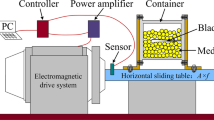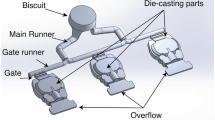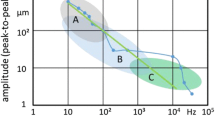Abstract
Severe casting defects exist on the cavity surface of aero-engine integral casting casing, leading to substandard cleanliness and surface integrity, which restricts the service performance of the casing. The finishing process for the complex cavity of casting casing is one of the technical bottlenecks in aero-engine manufacturing. Vibratory finishing has excellent potential for closed cavities because of the process media’s fluidized nature. In this work, taking the particle separator main casing of turboshaft aero-engine as a practice, based on the principle of vibratory finishing, a new idea of pre-loading the media and changing the spatial posture of the casing was proposed, and processing experiments were carried out. The vibration acceleration of the casing and the dynamic stress generated on the surface were measured, and the unfinished and finished surfaces were analyzed. The dynamic stress on the casing surface is far less than the fatigue strength of aluminum alloy (AlSi7Mg), which proves the feasibility of vibratory finishing for the casting casing. Meanwhile, the collision and scratching of the steel shot caused the surface roughness of the cavity to drop by 2 ~ 4 grades, and most of the carbon elements were removed. The finished surfaces had better surface morphology and cleanliness. Denser oxide film and lower surface roughness significantly improved the service performance of the casing, in which the corrosion resistance and mechanical properties were improved considerably. This process can provide a new approach for cavity finishing of other types of casings.

















Similar content being viewed by others
Data availability
The datasets supporting the results of this article are included within the article.
References
Coban K, Colpan CO, Karakoc TH (2017) Application of thermodynamic laws on a military helicopter engine. Energy 140:1427–1436. https://doi.org/10.1016/j.energy.2017.07.179
Filippone A, Bojdo N (2010) Turboshaft engine air particle separation. Prog Aerosp Sci 46:224–245. https://doi.org/10.1016/j.paerosci.2010.02.001
Potts JT (1990) Why an Engine Air Particle Separator (EAPS)? In: Volume 2: Aircraft Engine; Marine; Microturbines and Small Turbomachinery. American Society of Mechanical Engineers, Brussels, Belgium, p V002T02A026
Bojdo N, Filippone A (2014) Comparative study of helicopter engine particle separators. J Aircr 51:1030–1042. https://doi.org/10.2514/1.C032322
Hao Y, Yang S, Li X, Li W, Wang X (2021) Analysis of contact force characteristics of vibratory finishing within pipe-cavity. Granular Matter 23:32. https://doi.org/10.1007/s10035-021-01089-3
Tan KL, Yeo S-H, Ong CH (2017) Nontraditional finishing processes for internal surfaces and passages: a review. Proc Inst Mech Eng B J Eng Manuf 231:2302–2316. https://doi.org/10.1177/0954405415626087
Yu Z, Han B, Chen S, Chen Y, Yan Z (2017) Study on the inner surface finishing of irregular spatial elbow pipe by the centerline reconstruction. Int J Adv Manuf Technol 93:3085–3093. https://doi.org/10.1007/s00170-017-0762-7
Zhang J, Hu J, Wang H, Kumar AS, Chaudhari A (2018) A novel magnetically driven polishing technique for internal surface finishing. Precis Eng 54:222–232. https://doi.org/10.1016/j.precisioneng.2018.05.015
Guo J, Au KH, Sun C-N, Goh MH, Kum CW, Liu K, Wei J, Suzuki H, Kang R (2019) Novel rotating-vibrating magnetic abrasive polishing method for double-layered internal surface finishing. J Mater Process Technol 264:422–437. https://doi.org/10.1016/j.jmatprotec.2018.09.024
Dixit N, Sharma V, Kumar P (2021) Research trends in abrasive flow machining: a systematic review. J Manuf Process 64:1434–1461. https://doi.org/10.1016/j.jmapro.2021.03.009
Li J, Zhou Z, Wei L, Zhang X, Xu Y (2017) Quality influence and process parameter optimization of T-pipe in abrasive flow finishing. Adv Mech Eng 9:168781401771898. https://doi.org/10.1177/1687814017718980
Han S, Salvatore F, Rech J, Bajolet J, Courbon J (2020) Effect of abrasive flow machining (AFM) finish of selective laser melting (SLM) internal channels on fatigue performance. J Manuf Process 59:248–257. https://doi.org/10.1016/j.jmapro.2020.09.065
Sankar MR, Jain VK, Ramkumar J (2016) Nano-finishing of cylindrical hard steel tubes using rotational abrasive flow finishing (R-AFF) process. Int J Adv Manuf Technol 85:2179–2187. https://doi.org/10.1007/s00170-015-8189-5
Wang X, Zhang B, Qiao Y, Sun F (2021) Chemo-mechanical abrasive flow machining (CM-AFM): a novel high-efficient technique for polishing diamond thin coatings on inner hole surfaces. J Manuf Process 69:152–164. https://doi.org/10.1016/j.jmapro.2021.07.042
DehghanGhadikolaei A, Vahdati M (2015) Experimental study on the effect of finishing parameters on surface roughness in magneto-rheological abrasive flow finishing process. Proc Inst Mech Eng B J Eng Manuf 229:1517–1524. https://doi.org/10.1177/0954405414539488
Das M, Jain VK, Ghoshdastidar PS (2010) Nano-finishing of stainless-steel tubes using rotational magnetorheological abrasive flow finishing process. Mach Sci Technol 14:365–389. https://doi.org/10.1080/10910344.2010.511865
Furumoto T, Ueda T, Amino T, Hosokawa A (2011) A study of internal face finishing of the cooling channel in injection mold with free abrasive grains. J Mater Process Technol 211:1742–1748. https://doi.org/10.1016/j.jmatprotec.2011.05.018
Yamaguchi M, Furumoto T, Inagaki S, Tsuji M, Ochiai Y, Hashimoto Y, Koyano T, Hosokawa A (2021) Internal face finishing for a cooling channel using a fluid containing free abrasive grains. Int J Adv Manuf Technol 114:497–507. https://doi.org/10.1007/s00170-021-06893-y
Furumoto T, Ueda T, Amino T, Kusunoki D, Hosokawa A, Tanaka R (2012) Finishing performance of cooling channel with face protuberance inside the molding die. J Mater Process Technol 212:2154–2160. https://doi.org/10.1016/j.jmatprotec.2012.05.016
Nagalingam AP, Yuvaraj HK, Yeo SH (2020) Synergistic effects in hydrodynamic cavitation abrasive finishing for internal surface-finish enhancement of additive-manufactured components. Addit Manuf 33:101110. https://doi.org/10.1016/j.addma.2020.101110
Yang M, Li C, Zhang Y, Jia D, Zhang X, Hou Y, Li R, Wang J (2017) Maximum undeformed equivalent chip thickness for ductile-brittle transition of zirconia ceramics under different lubrication conditions. Int J Mach Tools Manuf 122:55–65. https://doi.org/10.1016/j.ijmachtools.2017.06.003
Zhang Y, Li C, Ji H, Yang X, Yang M, Jia D, Zhang X, Li R, Wang J (2017) Analysis of grinding mechanics and improved predictive force model based on material-removal and plastic-stacking mechanisms. Int J Mach Tools Manuf 122:81–97. https://doi.org/10.1016/j.ijmachtools.2017.06.002
Yang S, Li W (2018) Surface Finishing Theory and New Technology. Springer, Berlin
Zhao C, Zhang Y, Wen B (2010) Synchronisation and general dynamic symmetry of a vibrating system with two exciters rotating in opposite directions. Chinese Phys B 19:030301. https://doi.org/10.1088/1674-1056/19/3/030301
Zhang Y (2007) Mechanical vibration. Tsinghua University Press, Bei**g
Huang NE, Shen Z, Long SR, Wu MC, Shih HH, Zheng Q, Yen N-C, Tung CC, Liu HH (1998) The empirical mode decomposition and the Hilbert spectrum for nonlinear and non-stationary time series analysis. Proc R Soc Lond A 454:903–995. https://doi.org/10.1098/rspa.1998.0193
Empirical mode decomposition. https://ww2.mathworks.cn/help/wavelet/ref/emd.html. Accessed 19 Jan 2022
Chen Q, Li W, Jiang C, Zhou Z, Min S (2021) Separation and compensation of geometric errors of rotary axis in 5-axis ultra-precision machine tool by empirical mode decomposition method. J Manuf Process 68:1509–1523. https://doi.org/10.1016/j.jmapro.2021.06.057
Wan Y (2021) The modal and harmonic response analysis of final superheater based on workbench. IOP Conf Ser Earth Environ Sci 675:012177. https://doi.org/10.1088/1755-1315/675/1/012177
Peng C, Liu Y, Guo M, Gu T, Wang C, Wang Z, Sun C (2022) Corrosion and pitting behavior of pure aluminum 1060 exposed to Nansha Islands tropical marine atmosphere. Trans Nonferrous Met Soc China 32:448–460. https://doi.org/10.1016/S1003-6326(22)65806-0
Peng Y, Wu X, Shi K, Bu Z (2022) Adaptation system of carrier-based fighter engine. J Propuls Technol 43:62–69. https://doi.org/10.13675/j.cnki.tjjs.210070
** S, Zhang Z (2019) Corrosion and protection of naval Aeroengine. Int Combust Engine Parts 2:121–122. https://doi.org/10.19475/j.cnki.issn1674-957x.2019.02.058
Han W, Fang F (2021) Orientation effect of electropolishing characteristics of 316L stainless steel fabricated by laser powder bed fusion. Front Mech Eng 16:580–592. https://doi.org/10.1007/s11465-021-0633-7
Peng X (2019) Fatigue estimation based on stress RMS under stochastic excitation. IOP Conf Ser: Mater Sci Eng 563:042058. https://doi.org/10.1088/1757-899X/563/4/042058
Defanti S, Bassoli E (2021) Repeatability of the fatigue performance of additively manufactured A357.0 under different thermal treatment conditions. Mater Sci Eng A 805:140594. https://doi.org/10.1016/j.msea.2020.140594
Dong WP, Sullivan PJ, Stout KJ (1994) Comprehensive study of parameters for characterising three- dimensional surface topography: III: Parameters for characterising amplitude and some functional properties. Wear 178:29–43. https://doi.org/10.1016/0043-1648(94)90127-9
He B-F, Wei C-E, Liu B-X, Ding S-Y, Shi Z-Y (2018) Three-dimensional surface roughness characterization and application. Guangxue **gmi Gongcheng/Opt Precis Eng 26:1994–2011. https://doi.org/10.3788/OPE.20182608.1994
Turan D, Poulis JA (2022) The influence of the surface roughness, creep and relaxation on the performance of elastomeric liners for sustainable glass bottle closures. Food Packag Shelf Life 32:100840. https://doi.org/10.1016/j.fpsl.2022.100840
Pawlus P, Reizer R, Wieczorowski M (2020) Characterization of the shape of height distribution of two-process profile. Measurement 153:107387. https://doi.org/10.1016/j.measurement.2019.107387
Pawlus P, Reizer R, Wieczorowski M (2020) A review of methods of random surface topography modeling. Tribol Int 152:106530. https://doi.org/10.1016/j.triboint.2020.106530
Ye B, Zheng X, Haung X, Chen Y (2015) Remainder prevention measures for inter oil passage during manufacturing aeroengine parts. Aeronaut Manuf Technol 20:90–92. https://doi.org/10.16080/j.issn1671-833x.2015.20.90
**long L, Hongyun L, Tongxiang L (2016) Investigation of microstructure and corrosion behavior of burnished aluminum alloy by TEM, EWF, XPS and EIS techniques. Mater Res Bull 83:148–154. https://doi.org/10.1016/j.materresbull.2016.05.013
Shao Y-F, Wang Z-H, Li X, Li J-L, Gu C-Y (2020) Microstructure and properties of laser cladding co-based alloys on duplex stainless steel. Surf Technol 49:299–305. https://doi.org/10.16490/j.cnki.issn.1001-3660.2020.04.035
Zagar S, Grum J (2015) Roughness, residual stresses and pitting corrosion effect on shot peened AA 7075. Teh Vjesn 22:1589–1595. https://doi.org/10.17559/TV-20150624094336
Wang J, Mi Z, Jiang H, Wang R (2019) Texture-governed electrochemical corrosion behaviour of AA 6082 alloy. J Mater Sci 54:6608–6623. https://doi.org/10.1007/s10853-018-03303-9
Winiarski J, Tylus W, Szczygiel B (2016) EIS and XPS investigations on the corrosion mechanism of ternary Zn-Co-Mo alloy coatings in NaCl solution. Appl Surf Sci 364:455–466. https://doi.org/10.1016/j.apsusc.2015.12.183
Funding
The work was co-supported by the National Natural Science Foundation of China (Grant Nos. 52075362, 51875389, and 51975399) and the Scientific and Technological Innovation Project for Excellent Talents in Shanxi Province (Grant No. 201805D211031).
Author information
Authors and Affiliations
Contributions
Yupeng Hao designed and performed the manuscript, analyzed the data, and drafted the manuscript. Shengqiang Yang conceived and supervised the study, and edited the manuscript. Dongxiang Li performed the experiments, and Wenhui Li and **uhong Li analyzed the data. All authors read and approved the manuscript.
Corresponding author
Ethics declarations
Ethics approval
Not applicable.
Consent to participate
Not applicable.
Consent for publication
All authors have consent for publication.
Conflict of interest
The authors declare no competing interests.
Additional information
Publisher's note
Springer Nature remains neutral with regard to jurisdictional claims in published maps and institutional affiliations.
Rights and permissions
Springer Nature or its licensor (e.g. a society or other partner) holds exclusive rights to this article under a publishing agreement with the author(s) or other rightsholder(s); author self-archiving of the accepted manuscript version of this article is solely governed by the terms of such publishing agreement and applicable law.
About this article
Cite this article
Hao, Y., Yang, S., Li, D. et al. Vibratory finishing for the cavity of aero-engine integral casting casing: mechanism analysis and performance evaluation. Int J Adv Manuf Technol 125, 713–729 (2023). https://doi.org/10.1007/s00170-022-10728-9
Received:
Accepted:
Published:
Issue Date:
DOI: https://doi.org/10.1007/s00170-022-10728-9




